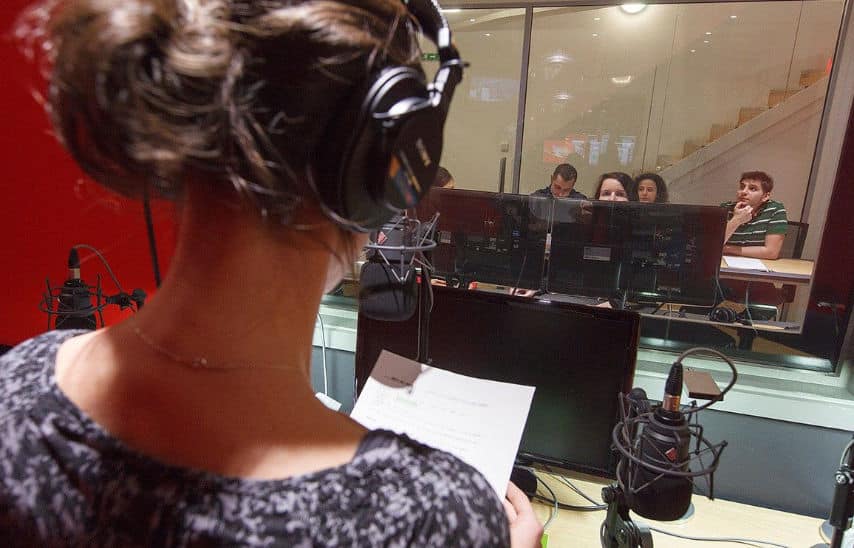Video translation refers to the process of converting the audio, captions, and/or subtitles of a video from one language to another. With the increasing globalization of businesses, organizations, and individuals, the importance of translate video has grown exponentially. The ability to communicate with audiences across linguistic and cultural barriers is vital for success in today’s globalized world. This article will explore the ins and outs of video translation, including its definition, types, process, advantages, challenges, and best practices. By the end, readers will have a solid understanding of video translation and its importance in modern communication.
Table of Contents
ToggleTypes of Video Translation
There are several different types of video translation, each with its own advantages and disadvantages. The three most common types of video translation are subtitling, dubbing, and voiceover.
Subtitling
Subtitling is the process of adding text on the screen that displays the translated dialogue while the original audio remains in the source language. Subtitles can be used for videos of any length, from short clips to feature-length films. Subtitling is an effective way to provide access to foreign language content without altering the original audio. Subtitles are also useful for viewers who are deaf or hard of hearing.
Subtitling has several advantages, including its cost-effectiveness and relatively quick turnaround time. Additionally, subtitling allows viewers to hear the original audio and intonation, providing a more authentic viewing experience. However, subtitling can be challenging for viewers who struggle to read quickly, and the presence of text on the screen can be distracting from the visual elements of the video.
Dubbing
Dubbing involves replacing the original audio with a voiceover in the target language. The new audio is synchronized with the original video to create a seamless final product. Dubbing is commonly used for movies, television shows, and other forms of entertainment where the visual aspect is just as important as the audio.
Dubbing has several advantages, including a more natural and immersive viewing experience for viewers who do not speak the source language. Additionally, dubbing can help preserve the original visual and audio elements of the video. However, dubbing can be costly and time-consuming, and finding appropriate voice actors who can match the original actors’ performances can be challenging.
Voiceover
Voiceover involves adding a new audio track in the target language without modifying the original audio. Voiceover can be a cost-effective alternative to dubbing, as it requires less time and resources. It is commonly used in documentaries, instructional videos, and e-learning materials.
Voiceover has several advantages, including its relative affordability and speed. Additionally, voiceover can preserve the original audio and intonation, providing a more authentic viewing experience. However, voiceover can be challenging for viewers who struggle to multitask between listening to the original audio and the voiceover.
The choice of which type of translation to use depends on the target audience, budget, and goals of the video. Each type of video translation has its own advantages and disadvantages, and it is important to choose the one that best suits the needs of the viewer and the content.
Video Translation Process
Video translation involves a multi-step process that includes transcription, translation, localization, and integration.
- Transcription
The first step in the video translation process is transcription. This involves creating a written version of the video’s dialogue, including any spoken words, sound effects, and music. The transcription provides the basis for the subsequent translation and localization steps. Depending on the complexity of the video, transcription can be done manually or through automated speech recognition technology. - Translation
Once the video has been transcribed, the next step is translation. This involves translating the written text from the source language into the target language. The translation should be accurate and faithful to the original dialogue while also accounting for cultural differences and linguistic nuances. - Localization
After the translation is complete, the next step is localization. Localization involves adapting the translated text to the target audience’s cultural and linguistic preferences. This includes modifying idiomatic expressions, adjusting references to cultural norms, and selecting appropriate vocabulary and tone. - Integration
The final step in the video translation process is integration. This involves incorporating the translated and localized text into the video itself. Depending on the type of video translation, this can include adding subtitles, dubbing or voiceover, or simply overlaying the translated text on top of the original video.
Throughout the translation process, it is important to maintain a high level of quality control to ensure accuracy and consistency. This includes reviewing the translated text for errors or omissions, testing the video with native speakers, and making any necessary adjustments. By following these steps, video translation can be an effective way to reach a global audience and provide access to foreign language content.
Advantages of Video Translation
Video translation can offer a range of benefits to businesses and individuals looking to reach a global audience. Here are some of the advantages of video translation:
- Increased reach and engagement
Translating videos can help businesses and individuals reach a wider audience by making their content accessible to people who speak different languages. This can lead to increased engagement and better brand awareness, which can ultimately lead to more customers and revenue. - Improved customer experience
By offering content in multiple languages, businesses can provide a better customer experience for their global audience. This can help to build trust and loyalty with customers, which can lead to repeat business and positive word-of-mouth marketing. - Greater accessibility
Translating videos can can also help to make content more accessible for people with hearing or visual impairments. Subtitling or closed captioning can provide a way for these audiences to understand the content, while audio descriptions can help to describe the visual elements of the video. - Increased brand awareness
Ausiovisual content in presented in different languages can help businesses build brand awareness in new markets by making their content accessible to people who speak different languages. This can help to establish a strong presence in new regions and build a loyal customer base. - Improved SEO rankings
Professionally translated video content can also help to improve search engine optimization (SEO) rankings by making content more accessible to people searching in different languages. By optimizing the translated content for relevant keywords, businesses can improve their visibility and attract more organic traffic to their website.
Overall, video translation can be a valuable investment for businesses and individuals looking to reach a global audience and improve their online presence. By making content accessible to people who speak different languages, this can lead to increase engagement, build brand awareness, and improve the customer experience.
Challenges of Video Translation
While video translation can offer many benefits, it also presents a number of challenges that must be overcome. Here are some of the challenges:
- Accuracy and attention to detail
It requires a high level of accuracy and attention to detail to ensure that the translated content is faithful to the original dialogue. This includes accounting for cultural nuances, idiomatic expressions, and technical jargon. Any mistakes or omissions in the translation can result in confusion or miscommunication. - Time-consuming and expensive
It can be a time-consuming and expensive process, particularly for longer or more complex videos. It requires a team of skilled professionals to handle the transcription, translation, localization, and integration steps. This can lead to increased costs and longer turnaround times. - Cultural differences
It also requires an understanding of cultural differences between the source and target audiences. This includes differences in language, customs, and norms. Failure to account for these differences can result in misunderstandings or offense to the target audience.
While there are challenges to overcome, the benefits of video translation can make it a valuable investment for businesses and individuals looking to reach a global audience.
Best Practices for Video Translation
To ensure success, it’s important to follow best practices that can help to improve the accuracy, effectiveness, and cultural appropriateness of the translated content. Here are some of the best practices:
- Simple and concise language
When translating video content, it’s important to use simple and concise language that is easy for the target audience to understand. This can help to avoid confusion and ensure that the message is communicated clearly. - Consistent message and tone
The translation should maintain a consistent message and tone throughout the content. This helps to ensure that the video remains coherent and effective in communicating the intended message. - Cultural sensitivity and relevance Cultural sensitivity and relevance are crucial considerations in translation. It’s important to understand the target audience’s culture and customs to ensure that the content is appropriate and relevant. This includes avoiding cultural stereotypes, using appropriate language, and adapting the content to suit the target audience’s preferences.
- High-quality equipment
Using high-quality equipment for video translation can help to ensure that the final product is of high quality and meets the expectations of the target audience. This includes using professional-grade cameras, microphones, and editing software.
Overall, following best practices for video translation can help to ensure that the translated content is accurate, effective, and culturally appropriate. This can help to improve the reach and engagement of the video, and ultimately lead to better results for businesses and individuals looking to reach a global audience.
Applications of Video Translation
Professionally translated videos can be used in a variety of applications to reach a wider audience and convey messages more effectively. Here are some of the common applications :
- Business communication and marketing
Videos can be used to communicate with customers and partners in different languages, expanding the reach of businesses and improving customer experience. It can also be used to translate marketing videos, allowing businesses to reach new markets and promote their products and services effectively. - Educational and training videos
Videos can be used to create educational and training videos for global audiences. This is particularly useful for e-learning platforms and international educational institutions, as it allows them to reach a wider audience and improve the accessibility of their content. - Entertainment and media content
Videos can also be used to translate entertainment and media content, such as movies, TV shows, and online videos. This can help to expand the reach of these products and make them accessible to audiences in different countries and regions. - Public announcements and government communications
Videos can be used by governments and public organizations to communicate important information to diverse audiences. This includes emergency alerts, public health announcements, and government policies, among others. - Personal communication and social media
Videos can also be used for personal communication, such as video calls and messaging with people who speak different languages. It can also be used on social media platforms, allowing individuals to create content that reaches audiences from different parts of the world.
With the increasing globalization of the world, the use of video translation is becoming more important than ever for businesses, individuals, and organizations looking to communicate more effectively with a global audience.
Future of Video Translation
The future of video translation is promising, with advancements in machine translation and artificial intelligence (AI) leading the way. Here are some of the trends that are likely to shape the future of video translation:
- Advancements in machine translation and AI Machine translation and AI technologies are becoming increasingly sophisticated, allowing for more accurate and natural translations. These technologies can be used to translate videos in real-time, making video translation faster and more accessible than ever before.
- Making video translation faster, more accurate, and more cost-effective
As video translation becomes more important for businesses and organizations, there is a growing need for faster, more accurate, and more cost-effective translation solutions. This has led to the development of new tools and technologies that can streamline the video translation process, such as cloud-based translation platforms, automatic subtitling and dubbing software, and video translation APIs. - Integration with other technologies
Video translation is also likely to become more integrated with other technologies, such as virtual and augmented reality (VR/AR) and voice assistants. This could allow for more immersive and interactive video translations, and make video content more accessible to people with disabilities.
Overall, the future of video translation is bright, with the potential to revolutionize how businesses and organizations communicate with global audiences. As advancements in technology continue, video translation is likely to become faster, more accurate, and more accessible, unlocking new opportunities for businesses, individuals, and organizations alike.
Video Translation Service Providers
When it comes to finding a reliable video translation service provider, there are several options to choose from. However, it can be overwhelming to decide which provider is the best fit for your specific needs. In this section, we will highlight GoLocalise, one of the most popular and reputable video translation service providers in the industry.
GoLocalise offers a comprehensive range of video translation services, including subtitling, voiceover, dubbing, and audio description. They employ a team of professional linguists and translators who are experts in their respective languages and cultures. This team works diligently to ensure that translations are accurate and culturally sensitive, while also maintaining the intended message and tone of the original content.
One of the major benefits of working with GoLocalise is their use of advanced translation technology. They employ the latest software and tools to ensure that translations are delivered quickly and cost-effectively, without sacrificing quality. Additionally, they offer a dedicated project manager to guide clients through the translation process and address any questions or concerns.
What truly sets GoLocalise apart from other video translation service providers is their commitment to customer satisfaction. They strive to understand each client’s unique needs and tailor their services accordingly. They take the time to communicate clearly and effectively with clients, ensuring that they are happy with the final product.
Whether you’re looking to translate business videos, educational content, or entertainment media, GoLocalise has the expertise and experience to help you reach a global audience. With their focus on quality and customer satisfaction, they are a top choice for video translation services.
Factors that Affect the Cost of Video Translation
One of the most significant concerns when it comes to video translation is the cost. There are several factors that can affect the overall cost of video translation, making it difficult to provide a specific rate card. However, it is still essential to have a clear understanding of the different cost elements to determine the budget and ensure a successful project.
Factors that Affect the Cost of Video Translation:
- Video length: Longer videos require more work and, therefore, cost more.
- Language pair: Some languages are more challenging to translate than others, and this can affect the cost.
- Quality: Higher quality translations require more time and resources, and, thus, cost more.
- Technical requirements: Some videos may require specific technical solutions, such as captioning, subtitling, or voiceover, which can affect the cost.
- Turnaround time: Urgent projects may incur additional costs due to expedited timelines.
It is essential to keep in mind that video translation involves multiple stages, including transcription, translation, localization, and integration, and each of these stages can affect the cost. Therefore, it is vital to choose a reliable and experienced video translation service provider that can provide a detailed breakdown of costs and work within your budget.
In conclusion, video translation is a crucial component for businesses and organizations to communicate with a global audience effectively. While the cost may be a concern, it is crucial to consider the long-term benefits and work with a reliable and experienced video translation service provider to ensure success.
Final Thoughts
Video translation has become an essential tool for businesses and individuals looking to reach a global audience. As we have seen, there are several types of video translation, each with its own advantages and challenges. It’s important to follow best practices and work with reputable service providers to ensure accurate and culturally sensitive translations. While video translation can be costly, it’s a worthwhile investment for those seeking to increase their reach, improve their customer experience, and boost their brand awareness. By considering the factors that affect the cost of video translation and staying up-to-date with the latest advancements in the field, businesses and individuals can make the most of this powerful tool. In a world where communication and connection are more important than ever, video translation is a crucial part of breaking down language barriers and connecting with audiences across the globe.
FAQs
What is video translation?
Video translation involves the process of translating audio and/or written text of a video from one language to another, so that the video can be understood by a broader audience.
What are the different types of video translation?
The most common types of video translation include subtitling, dubbing, and voiceover.
What are the benefits of video translation?
Video translation can increase the reach and engagement of your content, improve customer experience, and enhance brand awareness. It also provides greater accessibility to diverse audiences and improves SEO rankings.
Can machine translation be used for video translation?
While machine translation can be used for video translation, it’s important to note that it may not always produce accurate and culturally sensitive translations. It’s best to work with a professional video or audio translator or service provider to ensure the best possible results.
How much does video translation cost?
The cost of video translation depends on several factors such as the length of the video, the number of languages required, and the chosen method of translation. It’s best to obtain a quote from a reputable video translation service provider.
How accurate are video translations?
The accuracy of video translations depends on the quality of the translation and the expertise of the translators. Professional video translation service providers have experienced and qualified translators who ensure that the translations are accurate, culturally appropriate, and convey the intended message and tone.
How do I choose a reliable video translation service provider?
When choosing a video translation service provider, consider factors such as their experience, expertise, quality assurance processes, turnaround time, pricing, and customer support. Check for reviews and references from previous clients to gauge the provider’s reliability and quality of service.
Is it possible to add subtitles or captions to my existing videos?
Yes, it is possible to add subtitles or captions to existing videos. Video translation service providers can add subtitles or captions to the videos in the target language, making the content accessible to a wider audience. The cost of adding subtitles or captions depends on factors such as the length of the video, the number of languages, and the type of translation service.
Ready to expand your global audience with video translation? Contact GoLocalise today to get started! Don’t miss out on the opportunity to reach a wider audience and increase engagement with your content in over 300 languages.






















